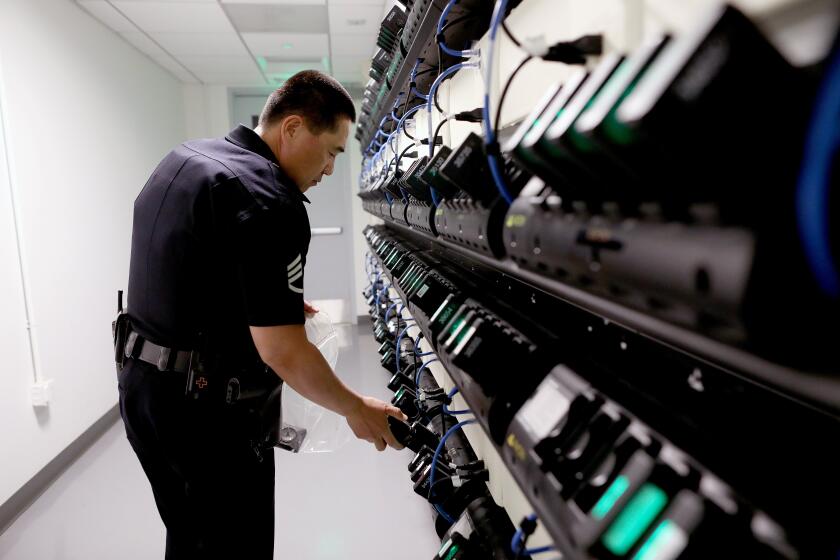Internal LAPD reports show body camera misuse more widespread than chief alleges

- Share via
For weeks after the Mission Division scandal broke in late August, Los Angeles Police Department Chief Michel Moore repeatedly framed the growing crisis as an isolated problem of rogue gang officers who flouted LAPD regulations by turning off their body-worn cameras at critical moments.
Moore said there was no evidence so far that other units were engaging in the more serious allegations facing Mission gang officers — who have been accused of theft, illegal stops and searches, and the use of Apple AirTags to track people, according to LAPD sources who requested anonymity to discuss internal matters.
But an internal department report found that the body camera issue is more widespread than the department is letting on publicly.
The confidential report by command staff from the 77th Street Division said that patrol officers from that division, as well as from the Hollenbeck and Hollywood divisions, were also in the habit of turning off their cameras in violation of department policy.
One possible explanation for these lapses, the report says, is a “real perception” that exists among many officers that they are “somehow excused” from turning on their cameras in time to capture encounters with the public, so long as they can articulate a clear reason for not doing so.
At the same time, some supervisors are under the impression that they are only required to review officers’ body camera footage in a narrow set of situations, the report said.
“Anecdotally, when speaking with my supervisors including my Watch Commanders, they provided a few reasons why a ‘deep review or investigation isn’t customarily done,” a division leader says in the report, which was obtained by The Times. “The overall belief by the Watch Commanders and supervisors is that aside from the requirement to review [body-worn and dashboard camera footage] for Personnel Complaints, Use of Force and Pursuit Investigations, the role of reviewing [body-worn and dashboard cameras] for Audits, Inspections, and Compliance Reviews is the responsibility of the Bureau Inspections Units or teams.”
The FBI has joined an investigation of several Los Angeles Police Department gang officers who are suspected of questionable tactics during traffic stops.
So-called quality service inspections of officers’ activity were suspended temporarily in March 2018 at the behest of the police union; a follow-up rule change said that such reviews could only be conducted by auditing units at the department’s four geographical bureaus and that they must be randomized.
The same audit did not turn up any body camera deviations at a fourth station, Foothill, a finding the report’s authors surmised might be the result of auditors not reading officers’ reports closely enough for language suggesting a possible deviation.
Officers in the other three divisions had noted in their reports why they failed to activate their cameras, but Foothill officers had not; only someone who reads an officers’ daily logs line-by-line would figure out that a violation had occurred, the report’s authors concluded.
Without addressing all of those issues, the report said that even with a greater emphasis on body camera compliance, officers would find other ways to get around the rules.
“If the expectation is that we should be conducting a deeper investigation into any documented ... deviation,” the report said, “I will tell you with confidence that officers will hear about this and will stop making these entries in the comments of their [reports] and no one would know any different unless their entry was selected as part of a random Bureau Inspection. If we want to make real progress, lets address this as well.”
LAPD rules don’t explicitly require supervisors to check body camera footage after they find a “deviation in the comments of [an officer’s] report,” and until recently, the report said, the department’s computer system couldn’t track whether such a review had been done.
The report said the department should consider studying the “feasibility” of adding to the workload of patrol supervisors, who are already tasked with the “voluminous work of reviewing [videos] ... for Use of Force and Pursuit Investigations and Complaint Intakes.”
After the controversy became public last month, Moore ordered additional training for all of the department’s gang units, and effectively disbanded the Mission gang unit, ordering two of its members to submit to disciplinary hearings for possible termination.
In the weeks since, Moore has on several occasions told reporters and the Police Commission — the department’s civilian bosses — that problems identified in Mission were confined to a single division, saying a broad review he’d ordered “found no evidence that this type of misconduct extends to any other division in the City.”
But even as he made public assurances, behind the scenes Moore ordered department auditors to start reviewing officers’ body camera videos for possible violations.
Auditors from the four geographical bureaus perform spot checks roughly
every four weeks by randomly reviewing gang unit stops “that don’t result in enforcement action.” Supervisors are supposed to ensure that an officer’s reports reflect what’s captured by their camera and look for potential red flags, including the use of canned language in reports and unexplained camera deactivations.
The department has since increased the frequency of these audits, according to LAPD spokesperson Capt. Kelly Muniz.
This has led to the discovery of scores of new violations, sources say.
The LAPD will review more recordings from body-worn cameras to make sure officers follow policy when dealing with the public.
According to two LAPD sources who spoke on condition of anonymity because they were not authorized to speak with the media, a preliminary investigation turned up multiple body camera policy violations in a recent police shooting in Hollywood.
In the Sept. 9 incident, officers opened fire after a suspect started shooting toward a group of people outside a nightclub near the corner of Hollywood Boulevard and Ivar Avenue, but no one was struck, police said. The alleged shooter, who hasn’t been identified, fled the scene and eventually eluded police in a high-speed chase.
When department officials reviewed police video from the scene, they found several so-called significantly involved officers were late to start recording or otherwise flouted the department’s body camera policy, according to sources.
A 2021 study by the department’s inspector general found that nearly a fourth of LAPD officers involved in incidents where serious force was used failed to activate their body cameras in a timely manner.
The report found that while the LAPD had ramped up inspections of body camera compliance among officers involved in serious uses of force, the department could be doing more to ensure officers are consistently activating their cameras and keeping them powered on while in the field.
A Times examination of department reports stemming from recent police shootings found that in many cases, officers were still failing to record their encounters with the public.
Of 37 police shootings that have gone before the civilian commission over the last year, 25 cases had some type of body camera violation by officers who were considered to be substantially involved, the Times review found.
These deviations included officers delaying to turn on their cameras, turning them off prematurely or failing to activate them entirely, as required. In another two shootings, some officers’ recordings did not include a full two-minute buffering period, which is sometimes the result of officers improperly activating their cameras.
In an email, LAPD Deputy Chief Robert Marino admitted that “there have been recent Categorical Use of Force Investigations where the involved officers had late activation.”
Officers were reminded of their obligations to record interactions with the public in a department-wide message, Marino said in the Sept. 15 email, a copy of which was obtained by The Times. He added that his office was working on a notice to supervisors about their “duties and responsibilities” to review officers’ reports and body camera videos.
Mark Smith, the commission’s inspector general, said last week that his office had been “closely monitoring” the LAPD’s investigation of the Mission gang unit from the beginning.
“Our monitoring is focused on ensuring that the investigation is impartial, unbiased, and thorough, and we will continue monitoring the investigation until it is complete,” Smith said in a statement. “Additionally, the [office] is currently in the planning phase of a review of all Department [gang enforcement details]. Our broad review of these units will be informed, in part, by the recent allegations involving the unit at Mission.”
The alleged misconduct in Mission came to light after a traffic stop in December: A motorist said that police had pulled him over and searched his vehicle without consent or probable cause. The motorist filed a complaint, and the ensuing internal investigation turned up other cases of Mission gang officers improperly switching off their cameras or otherwise failing to document stops.
As the department’s inquiry continued, allegations surfaced that some officers may have stolen items from people they pulled over.
The FBI is also investigating the unit for possible civil rights violations.
Times staff writer Richard Winton contributed to this report.
More to Read
Sign up for Essential California
The most important California stories and recommendations in your inbox every morning.
You may occasionally receive promotional content from the Los Angeles Times.
















